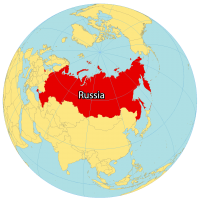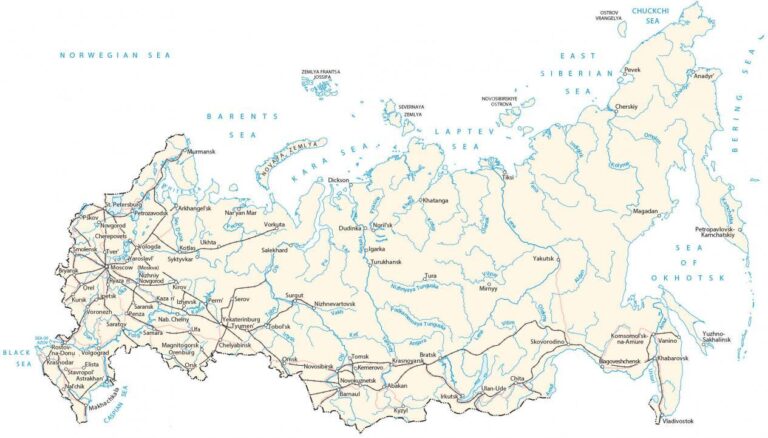About Russia
 Russia is the largest country in the world, spanning two continents and covering more than one-eighth of the Earth’s land area. With such vast territory and diverse landscapes, a map of Russia is an essential tool for anyone looking to explore this fascinating nation. It borders 14 countries, includes Azerbaijan, Belarus, China, Estonia, Finland, Georgia, Kazakhstan, North Korea, Latvia, Lithuania, Mongolia, Norway, Poland, and Ukraine.
Russia is the largest country in the world, spanning two continents and covering more than one-eighth of the Earth’s land area. With such vast territory and diverse landscapes, a map of Russia is an essential tool for anyone looking to explore this fascinating nation. It borders 14 countries, includes Azerbaijan, Belarus, China, Estonia, Finland, Georgia, Kazakhstan, North Korea, Latvia, Lithuania, Mongolia, Norway, Poland, and Ukraine.
History of Russia
I. Early History of Russia
- Origins of the Slavic people
- Kievan Rus and the Mongol invasion
- Rise of the Moscow principality
II. Imperial Russia
- Reigns of Peter the Great and Catherine the Great
- Expansion of the Russian Empire and the acquisition of Alaska
- Russo-Turkish Wars and the Balkan Crisis
- Bloody Sunday and the Russian Revolution
III. Soviet Era
- Rise of the Soviet Union and Bolshevik Revolution
- Stalin’s rule and the Great Purge
- World War II and the Siege of Leningrad
- Cold War and the Space Race
IV. Post-Soviet Russia
- Fall of the Soviet Union and the rise of the Russian Federation
- Economic reforms and the rise of oligarchs
- Chechen Wars and conflicts in the Caucasus region
- Putin’s rise to power and contemporary Russian politics
Evolution of Russia’s borders
- The early Slavic tribes that inhabited what is now Russia had fluid borders and often clashed with neighboring tribes.
- The Kievan Rus, the first unified state in the region, encompassed much of what is now Russia, Ukraine, and Belarus.
- The Mongol invasion in the 13th century led to the fragmentation of Kievan Rus and the emergence of various smaller principalities.
- The Moscow principality gradually expanded its borders over the centuries, eventually becoming the dominant state in the region.
- Under the rule of Peter the Great and Catherine the Great, Russia expanded its borders to include parts of present-day Poland, Finland, and the Baltic states.
- The Soviet era saw the annexation of several neighboring countries, including Belarus, Ukraine, and the Baltic states.
- With the fall of the Soviet Union, Russia lost many of its territories, including Finland and several former Soviet republics.
- Russia has engaged in territorial disputes with neighboring countries, including Ukraine and Georgia.
Physical Features of Russia
Russia is a country of great physical diversity, with a wide range of landscapes and natural features. Here are some of the key physical features of Russia:
-
Topography of Russia:
Russia has a varied topography, with a mix of plains, plateaus, mountains, and highlands. The European part of Russia is mostly flat, while the Asian part has more mountainous terrain.
-
Climate zones and weather patterns:
Russia spans 11 different time zones, and as such, experiences a wide range of weather patterns and climate zones. The northern regions are generally colder and experience longer winters, while the southern regions have a more temperate climate.
-
Major rivers, lakes and mountains:
Russia has some of the world’s largest and most iconic rivers, including the Volga, Ob, and Lena rivers. The country is also home to numerous lakes, including Lake Baikal, the deepest lake in the world. Russia’s most notable mountain ranges include the Caucasus Mountains, the Ural Mountains, and the Altai Mountains.
Regions and Cities of Russia
Russia is divided into 85 federal subjects, which are further subdivided into regions and cities. Here are some of the key regions and cities of Russia:
-
Moscow and Central Russia:
Moscow is the capital of Russia and the center of its political, economic, and cultural life. The city is famous for its stunning architecture, historic landmarks, and vibrant nightlife. The central region of Russia is also home to other notable cities such as Yaroslavl, Vladimir, and Kazan.
-
St. Petersburg and the Northwest:
St. Petersburg is Russia’s second-largest city and a major cultural center. Known as the “Venice of the North,” the city is famous for its stunning canals, baroque architecture, and rich cultural heritage. The Northwest region of Russia is also home to other important cities such as Novgorod, Pskov, and Murmansk.
-
Siberia and the Far East:
Siberia and the Far East cover the vast eastern part of Russia, with stunning landscapes, including vast forests, mountains, and a rugged coastline. The region is home to major cities such as Irkutsk, Novosibirsk, and Vladivostok, as well as unique cultural groups such as the Yakuts and Buryats.
-
Urals and Volga Region:
The Urals and Volga regions cover the central part of Russia, with the Ural Mountains acting as a natural divide between Europe and Asia. The region is home to major cities such as Ekaterinburg, Nizhny Novgorod, and Samara.
-
North Caucasus and Southern Russia:
The North Caucasus and Southern Russia are home to stunning mountain ranges, as well as unique cultural groups such as the Chechens and the Circassians. The region is also home to cities such as Rostov-on-Don, Sochi, and Krasnodar.
Cultural and Tourist Attractions
Russia is home to a wealth of cultural and touristic attractions, including:
-
Historic landmarks and monuments:
Russia is famous for its stunning landmarks and monuments, including the Kremlin and Red Square in Moscow, St. Basil’s Cathedral in Moscow, the Winter Palace in St. Petersburg, and the Catherine Palace in Pushkin.
-
Museums and art galleries:
Russia is home to some of the world’s most famous museums and art galleries, including the Hermitage Museum in St. Petersburg, the Tretyakov Gallery in Moscow, and the Russian Museum in St. Petersburg.
-
National parks and reserves:
Russia is home to a vast array of national parks and reserves, showcasing some of the country’s most breathtaking natural beauty. Some of the most popular include the Altai Mountains, Lake Baikal, the Kamchatka Peninsula, and the Caucasus Mountains.
-
Local festivals and celebrations:
Russia has a rich cultural heritage, and visitors can experience this through attending local festivals and celebrations. Some of the most popular include the Maslenitsa festival in February, the White Nights festival in St. Petersburg in June, and the Moscow International Film Festival in April.
Tips for Traveling to Russia
-
Visa and passport requirements:
Before you travel to Russia, be sure to check the visa and passport requirements for your country. Visitors from many countries need a visa to enter Russia, and the process can be time-consuming, so it’s important to start early.
-
Transportation options:
Russia is a vast country, and transportation options can vary depending on where you’re traveling. In larger cities like Moscow and St. Petersburg, there are metro systems, buses, and taxis. Trains are also a popular way to travel between cities.
-
Accommodation and dining suggestions:
Russia has a range of accommodation options, from budget hostels to luxury hotels. In larger cities, there are also many Airbnb options available. When it comes to dining, be sure to try traditional Russian cuisine, which includes dishes like borscht, blini, and pelmeni.
-
Safety and security advice:
Like any country, Russia has its own safety and security concerns. It’s important to be aware of your surroundings, especially in crowded areas like train stations and tourist attractions. Keep your belongings close and be cautious when using ATMs or exchanging money.

